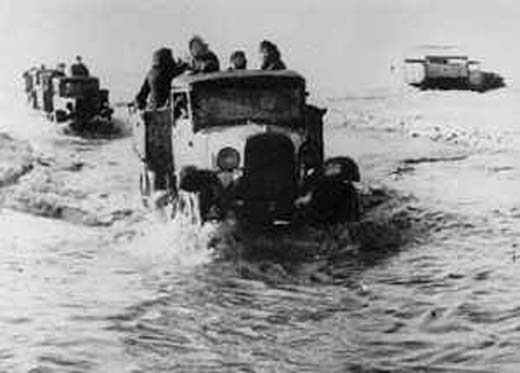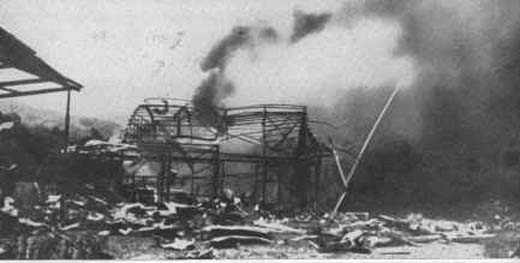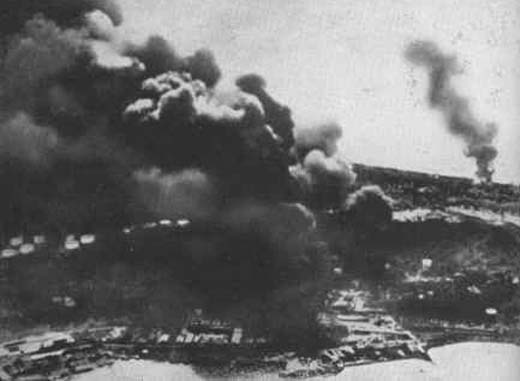Air Operations, Europe
BOMBER COMMAND- 47 aircraft are sent to Munster in the first inland raid of Germany in almost a month. Crews report large fires in the railway station area, but Munster records only report the death of 5 people with no other details. 1 Wellington is lost.
- In minor operations, 5 aircraft are sent to Dunkirk, 6 Blenheim Intruders to Dutch airfields, 9 Hampdens are involved in minelaying operations of the Frisians and Wilhelmshaven, and 5 Hampdens on leaflet flights over France. There are no losses.
Battle of the Atlantic
- U-588 sinks the British steamer Canadian Monarch (5851t) 30 miles north-northwest of Lewis, Outer Hebrides with the loss of all 46 crewmen.
- U-66 sinks the American steamer Norvana (2677t) south of Cape Hatteras with the loss of the entire crew of 29.
- U-333 sinks the Greek steamer Vassilios A. Polemis, a straggler from Convoy ON-53, 300 miles south of St John's, Newfoundland with the loss of 21 of her crew. 12 survivors are picked up 2 days later by the Greek steamer Leonidas N. Condylis.
- U-135 sinks the Belgian steamer Gandia (9626t), a straggler from Convoy ON-54, 420 miles east of Cape Race with the loss of 65 of her crew. 14 survivors are picked up by the American destroyer Bernadou and the Portuguese motor trawler João Corte Real.
- U-553 sinks the Norwegian tanker Innerøy (8260t) southeast of Nova Scotia with the loss of 36 crewmen. 5 survivors are landed at Halifax.
- U-82 sinks the British tanker Athelcrown (11,999t) southeast of Cape Race with the loss of 5 crewmen. 33 survivors are picked up by British steamer Argos Hill. 8 more are rescued by a British warship and 4 by the Swedish tanker Saturnus.
- U-130 sinks the Panamanian tanker Olympic (5335t) off North Carolina with the loss of her entire crew of 35.
Bismarck Archipelago
The Japanese occupy Mussau Island, north of New Ireland.
[Britain, Home Front
W. R. Sickert, painter and noted eccentric, dies at Bath at the age of 82.
[Eastern Front
The mass evacuation of the civilian population from Leningrad begins. Buses are used to ferry the evacuees over frozen Lake Ladoga. 440,000 will be taken out during the period beginning this day and ending April 15. The number of deaths in December is 52,000, the normal figure for a whole year. Even the rations of combat troops are reduced, from 3,500 to 2,600 calories. while all base and line of communication troops are given rations of only 1,600 calories. By the end of January the number of deaths from starvation and cold will pass 200,000. But the city still holds out.
Evacuation Via the 'Ice Road' |
 |
The Russians recapture Uvarova, 32 km west of Mozhaisk.
NORTHERN SECTORThe Soviet 3rd Shock Army increases itsl pressure on Cholm in an effort to take the town.
CENTRAL SECTORThe Stavka has withdrawn the 1st Shock and 16th Armies from this sector for redeployment, thus relieving the pressure on the 9th Army. Although the 39th Army continues to attack the 9th's positions, it is unable to break through. Indeed, a counterattack by XLVI Panzer Corps manages to stabilize the German frontline.
SOUTHERN SECTORThe Soviet 6th and 57th Armies lance 20 miles into the German front, heading for Barvenkovo.[MORE]
[Indian Ocean
I-64 sinks the Dutch steamer Van Overstraten (4482t) east-southest of Ceylon with the loss of the entire crew.
[Malaya
The battle on the Muar front ends in complete victory for the Japanese. Despite support from air and sea, the 45th Indian Div is destroyed. The forces defending Batu Pahat, units of the 11th Indian Div, have a few skirmishes with the enemy. On the east of the peninsula a Japanese attempt to break through at Mersing is repulsed. More Indian troops arrive to reinforce Singapore. The Japanese send 100 bombers to attack Singapore, causing many deaths and extensive damage.
[
|
|
North Africa
Rommel's men break through. By 1100 Group Marcks has capture Agedabia. They next race to Antelat followed by the Afrika Korps which falls at 1530. Fighters on the airfield there, Hurricanes and the new Kittyhawks, have to be man-handled to an area not waterlogged to enable them to take off. 2 damaged Hurricanes and 4 damaged Kittyhawks are destroyed on the ground but all the others escape. Group Marcks next swings east toward Saunuu which it captures in the evening. This move cuts off the 2nd Armored Brigade and the remaining advanced infantry units which are still southeast of Antelat.
The Axis troops in Africa are formally renamed Panzer Army Africa.
There are British air raids on Tripoli.
[Pacific
The Dutch steamer Lematang (2512t) is sunk by Japanese bombing at Belawan Deli in the Malacca Strait.
[Philippines
On Luzon, Gen MacArthur orders all American and Filipino forces to withdraw from the Mauban-Abucay line to the Bataan peninsula's final defense, behind the Pilar-Bagac road. The withdrawal is to be carried out over the next three days. In the II Corps area, the Japanese open an offensive that forces the Philippine Division back to positions east and south of Abucay Hacienda, approximately those held at the beginning of the counteroffensive of January 16. In the I Corps area, elements of the 91st Division (PA), supported by Scouts of the 26th Cavalry and tanks, attempt unsuccessfully to reduce the roadblock on West Road and to reach 1st Division troops still fighting along the main line of resistance to the north.
During the night the Japanese begin a series of amphibious operations, carrying troops southwards from Moron to Caibobo, south of Bagac attempting to establish a beachhead on the southern coast of the peninsula. 2 Japanese lighters are sunk by US motor torpedo boats.
[
